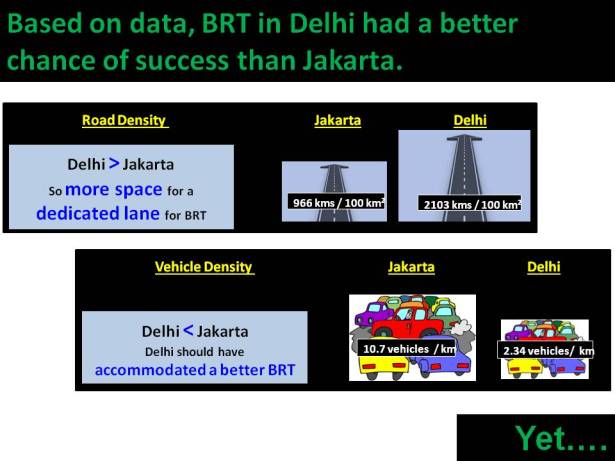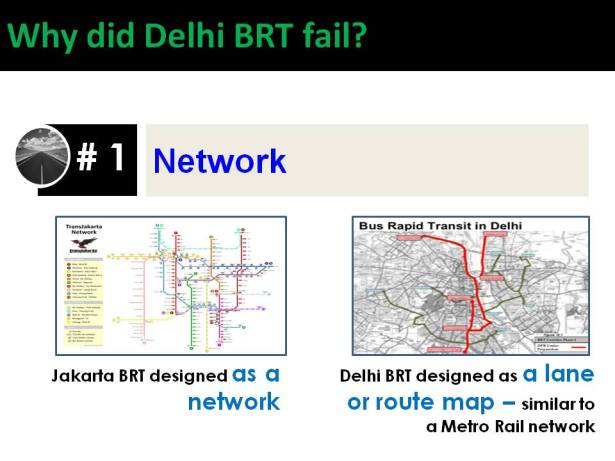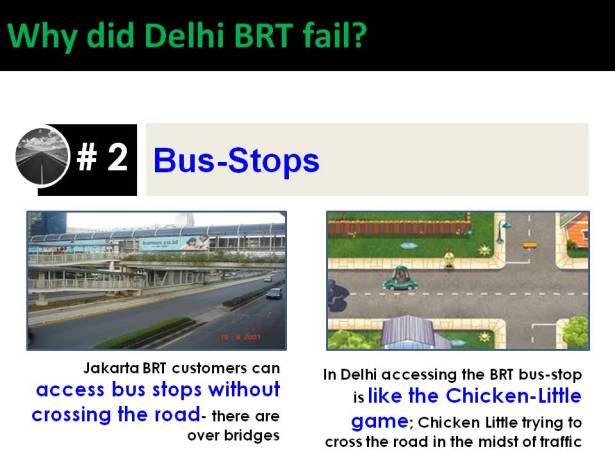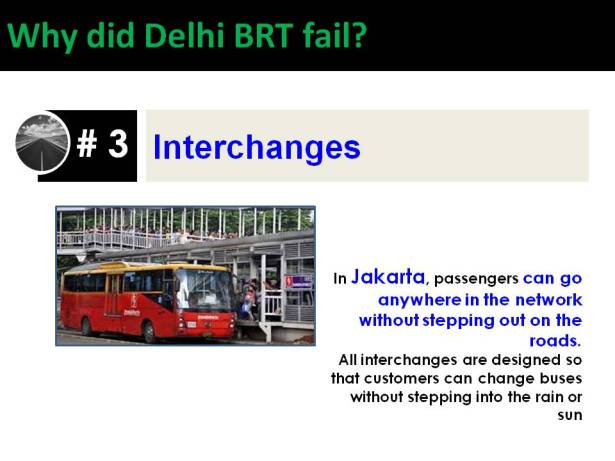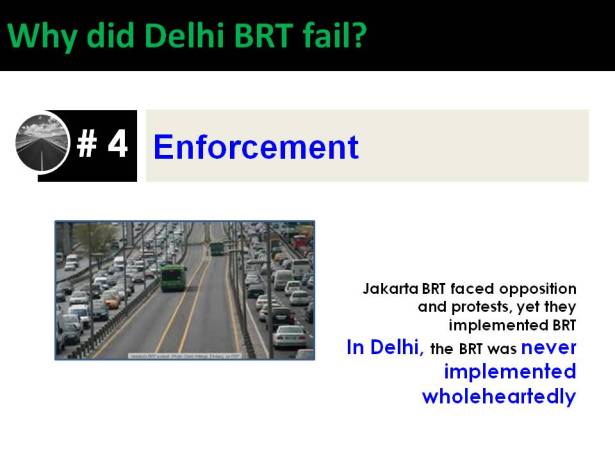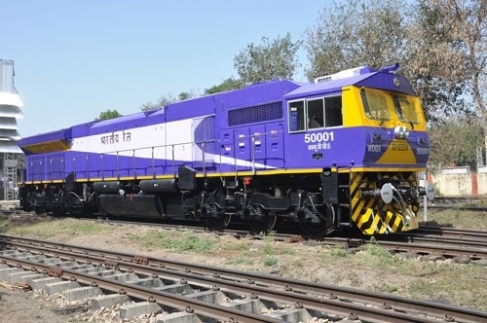
There has been a lot of discussion and debate in India on the Bullet Train between Ahmedabad and Mumbai. The High Speed Railway aka Bullet Train project was inaugrated during Japanese Prime Minister Shinzo Abe’s recent visit to India
There have been many questions on the bullet train. Some of the questions raised are
- Does India need a bullet train?
- What are the economics of the bullet train?
- Is the investment financially viable?
In this blog I will look at High Speed Railways in different parts of the world and their performance. I will use surrogates to check if the High Speed Railways is a viable proposition in India on the Mumbai-Ahmedabad and Mumbai-Delhi routes. I will also try to answer the question on whether India needs a High Speed Railway.
I will do a detailed calculation on the financials of the Mumbai-Ahmedabad High Speed Railway -some of you may glaze over it 🙂
High Speed Railways in different parts of the world.
High Speed Railway is defined as trains with speeds greater than 250kms per hour using dedicated and special rolling-stock (coaches, locomotives and power-cars).
Japan
Japan is where High Speed Railway was born.
In Japan the Tokkaido Shinkansen between Tokyo and Shin-Osaka opened in 1964, in time for the Tokyo Olympics.
After World War 2, Japan had many aeronautical engineers who had produced very good planes in World War 2. After the war, because of Japan’s pacifist policies, these aeronautical engineers could not work on aeroplanes. So they used their skills to design and construct trains. So the Shinkansen looks like an “aeroplane on rails”.
The Tokkaido- Shinkansen line, from Tokyo – Osaka (515 kms) , is the busiest High Speed Railway line in the world. When it started, the Shinkansen ridership was 700 passengers per day. Currently the ridership is 400,000 passengers per day.
The Shinkansen network is now expanded to 2764 kms with multiple Shinkansen lines- Tohoku , Sanyo , Hokkaido , Kyushu , Hokuriku , Joetsu , Yamagata , Akita.
The Japan Railway – Central, Japan Railway – East and Japan Railway – West which operate most of Shinkansens are profitable.
France
The TGV Sud-Est started operations in 1981 between Paris and Lyons (515 kms).
About 100,000 passengers take the train daily. The TGV has been designed to operate on conventional lines; it does not need dedicated high speed lines.
The TGV, since, has been extended in France and neighbouring countries – England, Belgium, Switzerland. The Eurostar and Thalys are TGV derivatives.
A TGV set the record for the world’s fastest train at 574 kms/ hour in 2007 (the record has since been broken by the Chinese HSR).
TGV services are squeezed for profits. But the high density TGV routes , Paris-Lyons and Paris-Nantes are profitable.
Taiwan:
In Taiwan, the HSR was opened in 2007, between Taipei and Kaohsiuing, a distance of 350kms. When it started, the ridership was 50,000 passengers per day which has risen to 140,000 per day currently.
Interestingly, after the HSR was introduced, within a few years 85% flights between Taipei and Kaohsiuing were discontinued. The passengers moved from air and buses. Bus passenger traffic dropped by 10%.
The Taiwan HSR covers 90% of Taiwan population.
The Taiwan HSR made operational profits within 4 months of start of operations. But on the books, it made a loss because the interest costs and depreciation were high.
China
China although a late entrant to the High Speed Railway now has the largest network of High Speed Railway in the world ~ 22000 kms.
The Beijing- Shanghai line is 1318 kms long; similar to the distance between Delhi and Mumbai. This line carried 150,000 passengers per day. The travel time is 4 hours 24 minutes on the fastest service.
The line is profitable.
The China High Speed Railway offers many lessons to India. Both countries have many cities with population of over 1 million, cities interspersed at distances between 350kms – 1000kms and high population density
There are other High Speed Railways operating in the world- Korea (Seoul-Busan), Uzbekistan (Tashkent-Samarkand).
Factors for success – high passenger traffic and financial viability – for the High Speed Railways
Demographics and Economics
Based on the study by JICA (Japan International Co-operation Agency), the break-even ridership for the Mumbai-Ahmedabad HSR is 22,000 per day (before loan repayment begins in 15 years). Now is this number achievable?
Based on an analysis of the profitable lines, my hypothesis is that the key drivers of ridership and hence, likely financial viability of the High Speed Railway are:
- Population of the cities connected by the High Speed Railway and
- The GDP of the cities connected by the High Speed Railway.
Now let’s analyse the Mumbai-Ahmedabad HSR from this logic – against the backdrop of data from other profitable HSRs.
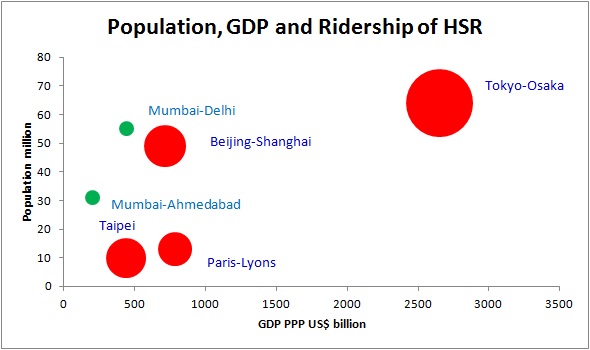
Graph showing ridership (size of bubble) co-related with GDP and Population
The ridership of 22,000 for Mumbai-Ahd HSR (indicated by the size of the green bubble) is much lower than other similar HSR lines ie. Taipei-Kaohsiuing and the Paris-Lyons TGV (in comparable time periods). Hence, this seems achievable.
As an aside, the Delhi-Mumbai HSR (if and when it is constructed) is similar to the Beijing-Shanghai in distance. But with a smaller GDP than Beijing-Shanghai, the ridership on the Mumbai-Delhi HSR is likely to be less than Beijing-Shanghai High Speed Railway – from the perspective of ‘ability to pay’.
Travel Time
High Speed Railway works well where the travel time is less than 5.5-6hrs – when door-to-door air travel becomes faster. This is also confirmed in studies in China.- Study 1 and Study 2, where conditions and assumptions would be comparable to India.
5.5-6hrs translates to a distance of 1000-1200 kms. One of the main reasons for the success of the High Speed Railway comes because passengers who earlier traveled by air between the origin-destination cities, move to the High Speed Railway. In many routes where HSR was started- Taipei-Kaohsiuing, Tokyo-Nagoya, Paris-Brussels – the flights were significantly reduced.
Let us compare travel times between Mumbai and Ahmedabad

Travel Time comparison – Mumbai to Ahmedabad – Air and Train
The travel time by the HSR is marginally higher. But cost of travel, punctuality and service (for eg. WiFi in train) may mitigate the marginally higher travel time.
So, from this perspective, Mumbai-Ahmedabad HSR should tick the box.
Additionally, the HSR will attract passengers who travel between intermediate cities (Surat, Bharuch, Vadodara etc.) whose current options would likely be bus or regular trains.
The Mumbai-Delhi line, on the other hand, whose distance is 1500 kms, may be debatable even though it may attract some traffic from intermediate cities like Vadodara, Ahmedabad, Jaipur – this line calls for more data and another blog post!
Other Factors:
In advanced countries, other factors for success – lower carbon emission and releasing capacity from passenger traffic for freight are considered.
The High Speed Railway by diverting traffic from air, reduces the carbon emission and hence is more “sustainable”. For developing countries like India and China, the primary consideration would still be financial viability – and lower carbon emission would only be a bonus.
In developed economies High Speed Railway passenger traffic diverts passenger traffic from the regular railway lines, freeing up capacity for more freight trains on those lines, increasing earnings for the railways. However, in India and China, the demand for regular passenger trains will always be high as demand far outstrips supply. So it is doubtful, if any passenger trains can be reduced after High Speed Railways operations start, to create path and capacity for freight trains.
Operational Viability vs Financial Viability:
For the 1st 15 years (2022-2037) the Expenses and Revenue on the Mumbai-Ahmedabad High Speed Railway are balanced. After 2037, the interest and principal have to be repaid. By 2037 Passenger ridership will have to increase to 50,000 per day, assuming fares in line with costs and expenses.
To summarize;
On the Ahmedabad-Mumbai High Speed Railway, the break-even ridership of 20,000 per day is reasonable. The travel time of ~ 4 hours is within the sweet-spot of High Speed Railways. These 2 key factors should make the Mumbai-Ahmedabad High Speed Railway, operationally viable within the 1st 15 years – before repayment starts. Financial viability – loan repayment from 2037 onwards – also seems possible with conservative estimates of increased ridership (see Annexure for detailed financial calculations).
The other High Speed Railway routes possible in India are Mumbai-Delhi (1500kms), Chennai-Bangalore (350kms) and Chennai-Hyderabad (630kms).
My belief is that High Speed Railways will induce more people to travel. It will unleash a “dormant” demand – people who needed to travel, but did not because of the higher cost of travel (by air) and the longer time needed to travel by regular train. In China also, the phenomenon of “dormant” demand for High Speed Railway was seen.
The other indicator, which increases my confidence in High Speed Railways is that air-travel in India is growing at ~16% per annum. This shows that there would be demand for High Speed Railways also.
Here is the link to a good study by the World Bank on China’s High Speed Railway.
Does India really need a HSR?
Maybe similar questions were asked when the Delhi Metro was being constructed. Today nobody questions the existence of Delhi Metro – in fact one cannot think of a Delhi without the Metro.
There are more good answers on this question of High Speed Railway on quora.
That said, I am going to share a cartoon by the great and legendary RK Laxman which says it all.
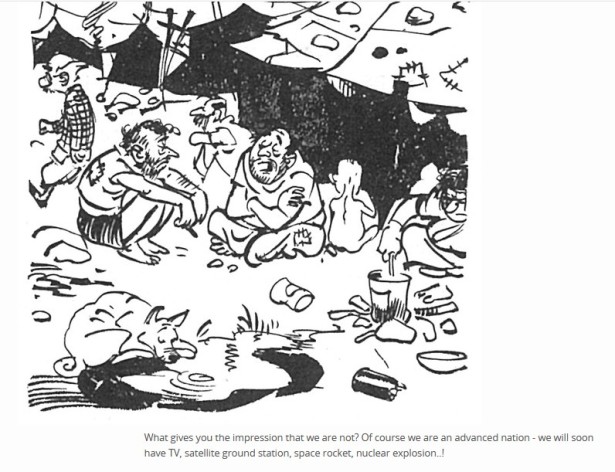
Who should manage the High Speed Railway?
The key to making this High Speed Railway a success, is good financial management, cost management and operations management.
The High Speed Railway should be managed and operated by a special purpose vehicle which should have experts from all fields to manage the project and then to run the operations.
This model has worked for Delhi Metro and should be used here.
This project should not be given wholly to the Indian Railways. The Indian Railways while a great organization has a poor track record in safety, financial management, project management, marketing management and strategic planning. The Indian Railways management has managed to run to ground the good and great organization that is the Indian Railways. (Discussing the issues of the Indian Railways will need a series of blogs!!)
Annexure:
Cost and Financial calculations of Mumbai-Ahmedabad High Speed Railway
I will work out the costs, expenses & revenue to determine the financial viability of the High Speed Rail.
For the High Speed Rail., Japan has given a loan of Rs 79000 crore (crore = 1 x 107 ) to be repaid over 50 years with a moratorium of 15 years. Indian Government will provide the balance Rs 19 billion.
To calculate the costs, I have used the data found on the internet.
I have appended the data below.

The highest costs have been assumed for the Mumbai Ahmedabad High Speed Rail
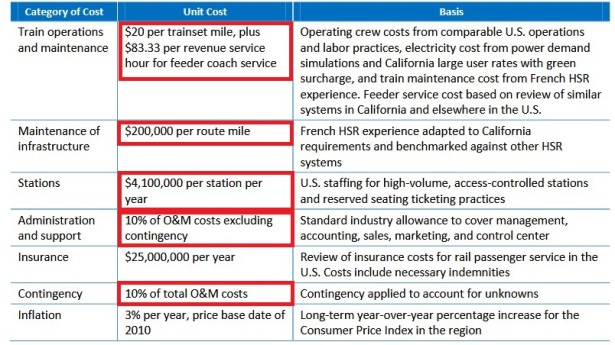
Costs of the High Speed Rail
I have used the highest costs, to be conservative.
Costs in the 1st 15 years of operation 2022-2037
Operations and Maintenance Costs
- Infrastructure Maintenance Costs: $ 200,000 per route mile per year
= US$ 200,000 x Rs 60 per US$ x 300 miles = Rs 360 Cr
- Equipment Maintenance Costs:
= US$ 10 x Rs 60 per US$ x 40 trains x 300 miles x 365 days per year
= Rs 270 Cr
- Train Operation & Maintenance Costs
= US$ 20 x Rs 60 per US$ x 40 trains x 300 miles x 365 days per year
= Rs 540 Cr
- Station Costs
= 15 Cr per station x 12 stations = Rs 180 Cr
- Adding Administration, Contingency Expenses of Rs 250 Cr per year
Total Costs = Rs 360 Cr + Rs 270 Cr + Rs 540 Cr + Rs 180 Cr + Rs 250 Cr = Rs 1600 Cr
Revenue
= Rs 2200 per one-way ticket x 20,000* passengers x 365 days = Rs 1600 Cr per year
So for the 1st 15 years, Expenses and Revenue are balanced.
After the 15 years moratorium, the interest and principal have to be returned.
Costs after the 15th year of operation 2037 onwards
Assuming that all Expenses increase @ 10% per year.
The breakup is as below;
- Infrastructure Maintenance Costs: Rs 1500 Cr
- Equipment Maintenance Costs: Rs 2250 Cr ( assuming double the number of trains from 40 train sets to 80 train sets)
Train Operation & Maintenance Costs: Rs 4500 Cr ( assuming double the number of trains from 40 train sets to 80 train sets)
3. Station Costs: Rs 750 Cr
4. Administration, Contingency Expenses : Rs 1050 Cr
5. Interest Cost:
0.1% x Rs 79,000 Cr = 79 Cr per year
6. Capital:
Rs 79,000 Cr / 35 years = Rs 2260 Cr year
Total Cost of Borrowing = Rs 2350 Cr
Total Cost = Rs 1500 Cr + Rs 2250 Cr + Rs 4500 Cr + Rs 750 Cr + Rs 1050 Cr + Rs 2350 Cr + = Rs 12400 Cr
To get a Revenue equal to Rs 12400 Cr, in 2038, Passenger ridership will have to increase to 55,000 per day and Price of a one-way ticket will have to increase to Rs 6250 @ ~ 9.5% per year.
So the financial viabilty of the project after 15 years is possible. The financial viability depends on keeping costs low, running the operations efficiently and passenger traffic increasing.
| Year 2022
(All figures in Rs Cr) |
Year 2037
(All figures in Rs Cr) |
|
| Infrastructure Maintenance Costs | 360 | 1500 |
| Train Operation & Maintenance Costs | 540 | 4500 |
| Station Costs | 300 | 1250 |
| Administration, Contingency Expenses | 100 | 425 |
| Interest | 0 | 79 |
| Capital | 0 | 2260 |
| Total Costs | 1300 | 10025 |
| Price per ticket | 2200 | 6075 |
| Passengers | 20000 | 55000 |
| Revenue | 1320 | 10025 |
There is one more variable in the costs- the risk of INR-YEN exchange rate fluctuation.
I am assuming the loan is denominated in YEN. I do not know for sure if the loan is denominated in INR or YEN.
Looking at data of the past 5 years, it seems that the INR-YEN exchange rate is stable and varies in a narrow band. So, Exchange Rate risk should be low.
So the financial risks are;
- Passenger traffic has to grow at 7% per year for 15 years
- Passenger fares have to increase @ 9.5% per year
- INR-YEN has to be fairly stable
Mitigating factors:
- Costs are taken at the highest levels; cost could be lower
- Revenue from other non- ticket streams – advertisement, space rental at stations- is not considered
- INR-YEN Swap Deal can be done to mitigate the exchange rate risk
To summarize, for the 1st 15 years the Mumbai-Ahmedabad High Speed Railway is financially viable. By 2037, the ridership should have increased sufficiently to make the Mumbai-Ahmedabad High Speed Railway financially viable.
